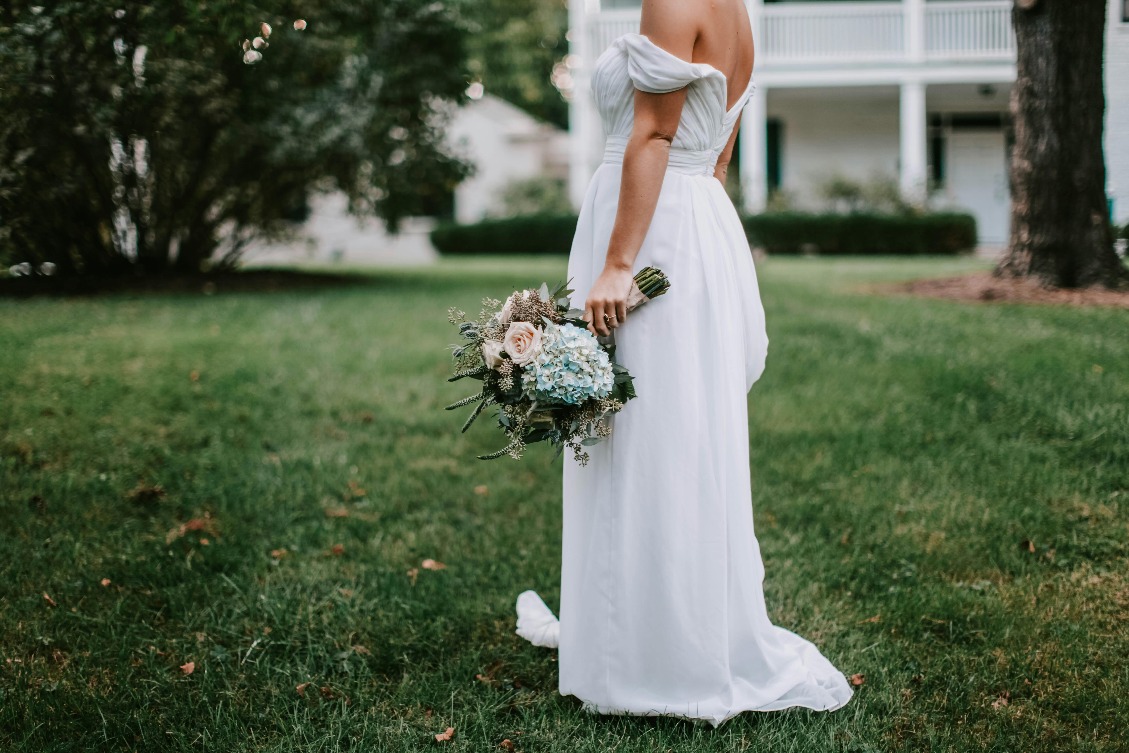- trains
- monarch / royal
- cathedral
- semi-cathedral
- chapel
- court
- sweep / brush
- skirts
- floor length
- full length
- high-low
- tea length
- midi
- knee length
- mini
trains
A train is the part of the skirt that extends on to the floor.
monarch / royal
Monarch trains are the longest and most dramatic - there's not really a limit to how long they can be, but anything over 2.5m measured from the waist qualifies, with 3m - 3.5m being the most popular length in this category. You need an extremely spacious venue and extremely helpful bridesmaids to accommodate a skirt of this length, but they certainly make a dramatic statement.
cathedral
Cathedral trains are between 1.8m - 2.5m long, measured from the waist. They're usually designed with grand indoor venues like cathedrals, ballrooms and estates in mind, where you can make a dramatic walk down a long, wide aisle with the train following behind you. You need very helpful bridesmaids to aid you in keeping this voluminous skirt neat, but they're a very popular option for brides looking for a dramatic or fairytale feeling.
semi-cathedral
Shorter than cathedral length but longer than chapel length, semi-cathedral trains fall between 1.2m - 1.5m long, measured from the waist. This in-between length means that they still make a dramatic statement, but are slightly lighter and easier to manage than a full cathedral train.
chapel
Chapel trains are between 0.9m and 1.2m long, measured from the waist. They're a timeless option, and are the most popular train length for modern brides, as they still provide that formal, sweeping, statement bridal look, but are more comfortable and easier to manage than the longer options.
court
Court trains are only 0.3 long, measured from the bottom of the skirt. They mean that you still get the formality of having a longer-than-floor-length gown, but can avoid the weight and hassle of a longer train.
sweep / brush
Court trains are only 0.3 long, measured from the bottom of the skirt. They mean that you still get the formality of having a longer-than-floor-length gown, but can avoid the weight and hassle of a longer train.
skirts
If you decide that you don't want a train, there are still plenty of different options for the length of your dress.
floor length
High-low dresses, as the name suggests, feature skirts that are cut higher at the front and fall to floor in the back. You can increase the drama by having the front cut to above the knees and the back billowing in a long, dramatic train, or you can simply have the front cut just high enough to show off your shoes.
full length
High-low dresses, as the name suggests, feature skirts that are cut higher at the front and fall to floor in the back. You can increase the drama by having the front cut to above the knees and the back billowing in a long, dramatic train, or you can simply have the front cut just high enough to show off your shoes.
high-low
High-low dresses, as the name suggests, feature skirts that are cut higher at the front and fall to floor in the back. You can increase the drama by having the front cut to above the knees and the back billowing in a long, dramatic train, or you can simply have the front cut just high enough to show off your shoes.
tea length
Tea-length dresses have fitted bodices and skirts that fall from the natural waist to just above the ankle. They're perfect for vintage-style weddings or those that are a bit more casual, and are a popular choice for courthouse ceremonies.
midi
Midi dresses have hemlines that fall to mid-calf. They can be fitted or flowy, depending on the cut of the skirt and the fabric, but they're an always charming choice, popular for more casual weddings and courthouse ceremonies.
knee-length
As the name suggests, knee-length dresses have hemlines that fall right to the knee. They usually have a fitted bodice and a skirt that flares out, and they're a fun option, popular for elopements and destination weddings.
mini
Mini dresses have hemlines that fall above the knee. They can be fitted or flowy, depending on the cut of the skirt and the fabric, but they're a always a bold choice, popular for more casual weddings, elopements and courthouse ceremonies. Many modern brides choose a more traditional style dress for their ceremony and photos before changing into a mini dress for their reception.

